Samsung NP-R540-JSE1US User Manual
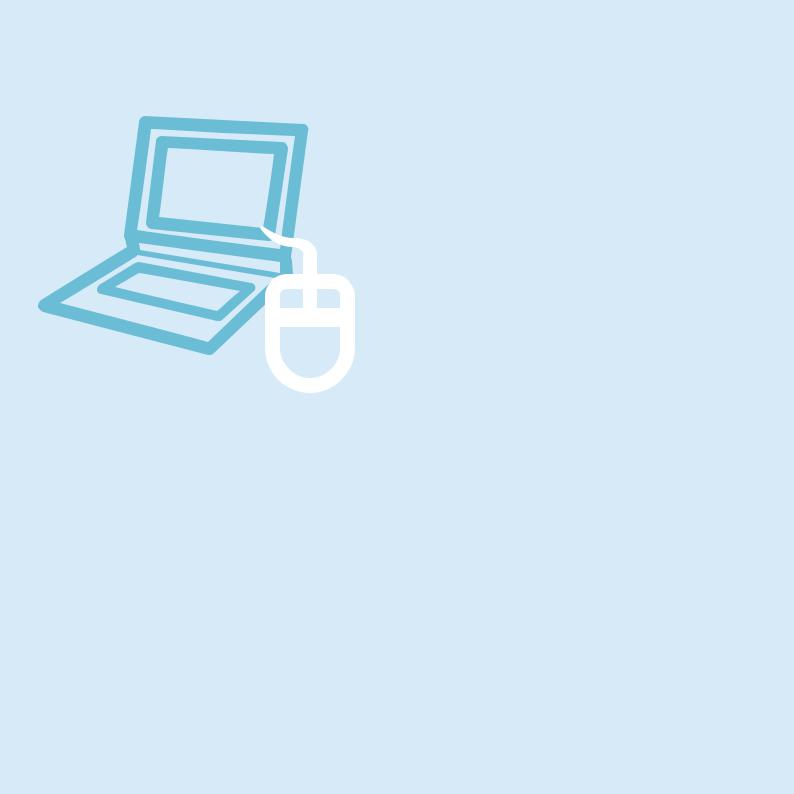
Chapter 1.
Getting Started
Product Features |
2 |
Before You Start |
3 |
Contents |
6 |
Safety Precautions |
7 |
Proper Posture During Computer Use |
21 |
Important Safety Information |
24 |
Replacement Parts and Accessories |
26 |
Regulatory Compliance Statements |
28 |
WEEE SYMBOL INFORMATION |
40 |
Overview |
41 |
Front View |
1 |
Status Indicators |
|
Right View |
3 |
Left View |
|
Left View |
5 |
Back View |
|
Bottom View |
7 |
Turning the Computer On and Off |
48 |
Turning the computer on |
8 |
Turning the computer off |
9 |
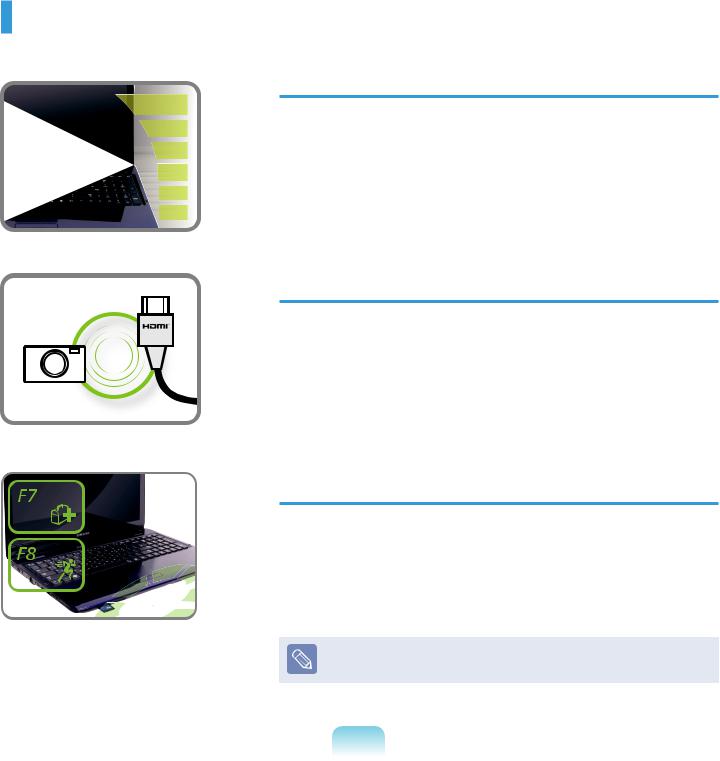
Product Features
High-Performance Notebook Computer
Intel Celeron/Pentium Dual Core/i3, i5, i7(Core) Processor and DDR3 Memory (Optional)
Wireless LAN (Optional)
Supports Various Multimedia Functions
A video chatting/conference function adopting the camera module (Optional)
An HDMI port that enables viewing a full HD picture on the TV (Optional)
Easy-to-Use and Convenient Functions
Various Hot Key Functions
Multi-Card Slot (Optional)
Luxurious, Ergonomic Design
Optional items may be changed or may not be provided depending on the computer model.
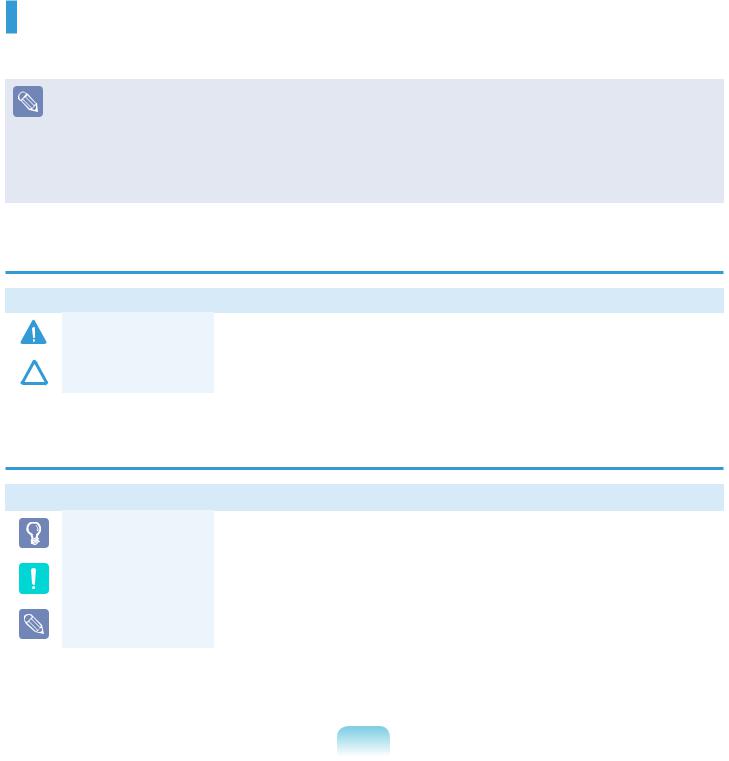
Before You Start
Before reading the User Guide, first check the following information.
Optional items, some devices and software referred to in the User Guide may not be provided and/or changed by upgrade. Note that the computer environment referred in the User Guide may not be the same as your own environment.
Images used in this User Guide may differ from actual product.
This guide decribes procedures for using both the mouse and the touchpad.
This manual has been written for the Windows operating system. The descriptions and figures may differ depending on the installed operating system.
The User guide supplied with this computer may vary depending on your model.
Safety Precaution Notations
Icon |
Notation |
Description |
|
|
|
|
Warning |
Failing to follow instructions marked with this symbol, may cause personal injury and or |
|
fatality. |
|
|
|
|
|
|
|
|
Caution |
Failing to follow instructions marked with this symbol, may cause slight injury to yourself or |
|
damage your property. |
|
|
|
|
|
|
|
Text Notations
Icon |
Notation |
Description |
|
|
|
|
Before You Start |
Content included in this section includes information required before using a function. |
|
|
|
|
Caution |
Content included in this section includes information required about the function. |
|
|
|
|
Note |
Content included in this section includes helpful information to use the function. |
|
|
|

Copyright
© 2010 Samsung Electronics Co., Ltd.
Samsung Electronics Co., Ltd. owns the copyright of this manual.
No part of this manual may be reproduced or transmitted in any form or by any means, electronic or mechanical, without the consent of Samsung Electronics Co., Ltd.
The information in this document is subject to change without notice due to improving the performance of the product.
Samsung Electronics shall not be liable for any data loss. Please take care to avoid losing any important data and backup your data to prevent any such data loss.
Precautions for Operating System Support
If a problem occurs because of the reinstallation of other operating systems(OS) or a previous version of a OS preinstalled on this computer, or a software that does not support the OS, the company will not provide technical support, a replacement or refund, and if our service engineer visits you due to this problem, a service charge will be applied.
About the Product Capacity Representation Standard
About HDD Capacity Representation
The capacity of the storage device (HDD, SSD) of the manufacturer is calculated assuming that 1KB=1,000 Bytes.
However, the operating system (Windows) calculates the storage device capacity assuming that 1KB=1,024 Bytes, and therefore the capacity representation of the HDD in Windows is smaller than the actual capacity due to the difference in capacity calculation.
(E.g. For a 80GB HDD, Windows represents the capacity as 74.5GB, 80x1,000x1,000x1,000 byte/ (1,024x1,024x1,024)byte = 74.505GB)
In addition, the capacity representation in Windows may be even smaller because some programs such as Recovery Solution may reside in a hidden area of the HDD.
About Memory Capacity Representation
The memory capacity reported in Windows is less than the actual capacity of memory.
This is because BIOS or a video adapter uses a portion of memory or claims it for further use. (E.g. For 1GB(=1,024MB) memory installed, Windows may report the capacity as 1,022MB or less)

Recovery Solution Representation (Optional)
Q.What is a Recovery Area?
A.– Samsung computers have an additional partition to recover computers or save backup files. (Only for models with the Samsung Recovery Solution.)
This partition is called a Recovery Area and it includes a recovery image that comprises of the OS and application programs.
-You can either double-click the Samsung Recovery Solution icon on the desktop or press F4 while booting the computer to enter the Recovery Area. Then you can back up the present computer state or recover the computer from backed up images.
-For deleting the Recovery Area, you need to use an additional Recovery Area Removal Tool. After deleting the recovery area, you can use the newly created partition for other uses, such as for saving personal data. Be careful that once the recovery area is deleted, the Samsung Recovery Solutions will not work anymore.
Q.The capacity representation of the hard disk drive(HDD) in Windows is different from the product specifications.
A.- The capacity of the storage device (HDD) of the manufacturer is calculated assuming that 1KB=1,000 Bytes. However, the operating system (Windows) calculates the storage device capacity assuming that 1KB=1,024 Bytes, and therefore the capacity representation of the HDD in Windows is smaller than the actual capacity. This is due to the difference in capacity calculation and does not mean the installed HDD is different from the product specifications.
-The capacity representation in Windows may be smaller than the actual capacity because some programs occupy a certain area of the HDD outside of Windows.
-For models with Samsung Recovery Solution, the HDD capacity representation in Windows may be smaller than the actual capacity because Samsung Recovery Solution uses a hidden area of about 5~20GB of the HDD to save the recovery image, and that hidden area is not counted towards the total size available to Windows. The size of Samsung Recovery Solution varies by models because of the different size of applied programs.

Contents
Chapter 1. Getting Started
Product Features |
2 |
Before You Start |
3 |
Contents |
6 |
Safety Precautions |
7 |
Proper Posture During Computer Use |
21 |
Important Safety Information |
24 |
Replacement Parts and Accessories |
26 |
Regulatory Compliance Statements |
28 |
WEEE SYMBOL INFORMATION |
40 |
Overview |
41 |
Front View |
41 |
Status Indicators |
42 |
Right View |
43 |
Left View |
44 |
Left View |
45 |
Back View |
46 |
Bottom View |
47 |
Turning the Computer On and Off |
48 |
Turning the computer on |
48 |
Turning the computer off |
49 |
Chapter 2. Using the Computer
Keyboard |
52 |
Touchpad |
55 |
Basic Touchpad Functions |
56 |
The Gesture Function of the Touchpad (Optional) |
58 |
Touchpad On/Off Function |
60 |
CD Drive (ODD, Optional) |
61 |
Inserting and Ejecting a CD |
61 |
Multi Card Slot (Optional) |
62 |
ExpressCard Slot (Optional) |
65 |
Connecting a monitor / TV |
66 |
Connecting to the Monitor / TV |
66 |
Viewing Through a Monitor / TV |
68 |
Using Dual View |
73 |
Adjusting the Volume |
76 |
Wired Network |
80 |
Wireless Network (Optional) |
83 |
Connecting to a Wireless LAN |
83 |
Sharing Content in a Home Network |
86 |
(Easy Content Share) (Optional) |
|
Configuring the network settings for your computer |
|
and TV |
86 |
Adding shared content on your computer |
88 |
Playing content on your TV using your computer |
88 |
Playing the content stored on a computer when Easy |
|
Content Share is not installed |
90 |
Chapter 3. Settings and Upgrade
LCD Brightness Control |
94 |
BIOS Setup |
95 |
Entering the BIOS Setup |
95 |
The BIOS Setup Screen |
96 |
Setting a Boot Password |
98 |
Changing the Boot Priority |
100 |
Upgrading Memory |
101 |
Battery |
103 |
Installing/Removing the Battery |
103 |
Charging the Battery |
104 |
Measuring the Remaining Battery Charge |
105 |
Extending the Battery Usage Time |
106 |
Using the Security Lock Port |
107 |
Chapter 4. Troubleshooting
Using Samsung Recovery Solution |
109 |
Samsung Recovery Solution Functions |
109 |
Restore Function |
112 |
Backup Function |
115 |
System Software Function |
119 |
Reinstalling Windows 7/Vista |
121 |
Reinstalling Windows XP |
125 |
Q & A |
129 |
Windows Related |
129 |
Display Related |
131 |
Sound Related |
133 |
Wired Network (LAN) Related |
134 |
Wireless Network (WLAN) Related |
136 |
Game and Program Related |
140 |
Bluetooth (Optional) |
141 |
Easy Content Share Related |
142 |
Chapter 5. Appendix
Product Specifications |
146 |
Glossary |
148 |
Index |
151 |
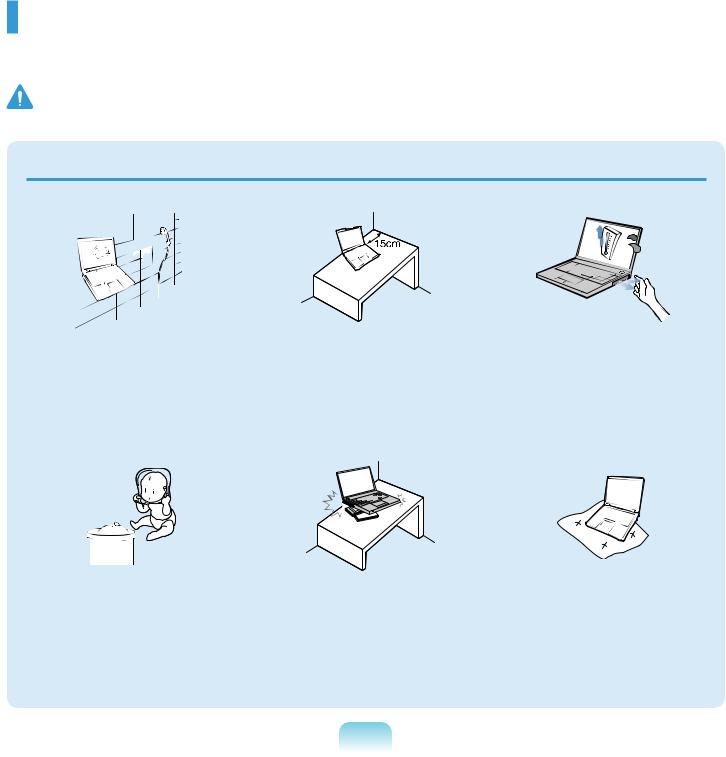
Safety Precautions
For your security and to prevent damage, please read the following safety instructions carefully.
Since this is commonly applied to Samsung Computers, some pictures may differ from actual products.
Warning
Failing to follow instructions marked with this symbol may cause personal injury and even fatality.
Installation Related
Do not install the product in places exposed to humidity such as a bathrooms.
There is a danger of electric shock. Use the product within the
operating conditions specified in the
Manufacturers User Guide.
Keep the plastic bags out of the reach of children.
There is a danger of suffocation.
Keep a distance of 15cm or more between the computer and the wall and do not place any objects between them.
This may increase the internal temperature of the computer and may cause an injury.
Do not install the computer on a slant or a place prone to vibrations, or avoid using the computer in that location for a long time.
This increases the risk that a malfunction or damage to the product will occur.
Avoid exposing any part of your body to the heat from the computer vent or AC adapter for a long time when the computer is on.
Exposing a part of your body close to the heat from the vent or AC adapter for long periods of time may cause a burn.
Avoid blocking the vent at the bottom or side of the computer when using it on a bed or cushion.
If the vent is blocked, there is a danger of damaging the computer or overheating the inside of the computer.
NP Ver 2.3
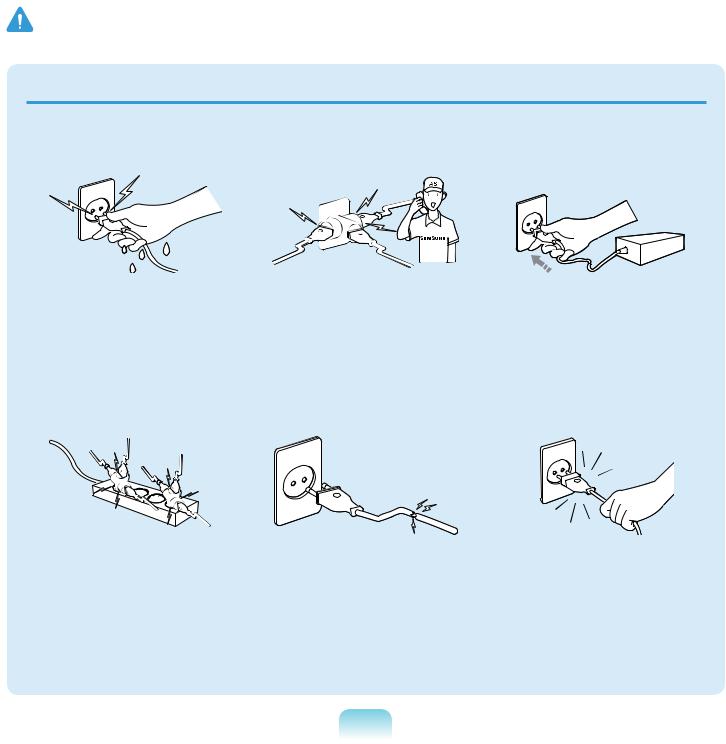
Warning
Failing to follow instructions marked with this symbol may cause personal injury and even fatality.
Power Related
The power plug and wall outlet figures may differ depending on the country specifications and the product model.
Do not touch the main plug or power cord with wet hands.
There is a danger of electric shock.
Do not exceed the standard capacity (voltage/current) of a multiplug or power outlet extension when using it for the product.
There is a danger of electric shock or fire hazard.
If the power cord or power outlet makes a noise, disconnect the power cord from the wall outlet and contact a service center.
There is a danger of electric shock or fire hazard.
Do not use a damaged or loose main plug or power cord or power outlet.
There is a danger of electric shock or fire hazard.
Plug the power cord firmly into the power outlet and AC adapter.
Failing to do so may cause fire hazard.
Do not unplug the power cord out by pulling the cable only.
If the cord is damaged, it may cause electric shock.
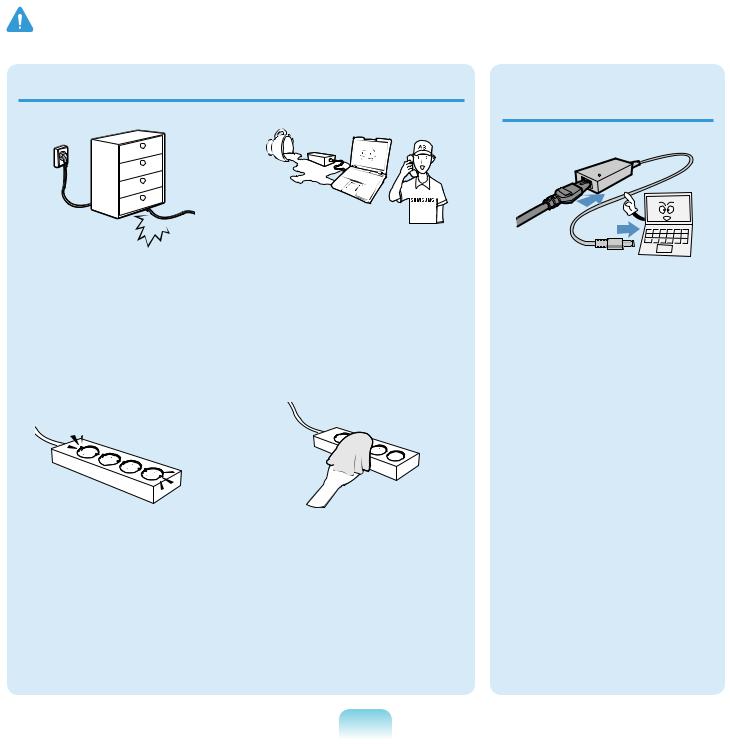
Warning
Failing to follow instructions marked with this symbol may cause personal injury and even fatality.
AC Adapter Usage
Precautions
Do not bend the power cord excessively or do not place a heavy object over the power cord. It is especially important to keep the power cord out of reach of infants and pets.
If the cord is damaged, it may cause electric shock or fire.
Connect the power cord to an outlet or multiple power plug (extended cable) with a ground terminal.
Failing to do so may result in electric shock.
If water or another substance enters the power input jack, AC adapter or the computer, disconnect the power cord and contact the service center.
Damage to the device within the computer may cause electric shock or fire hazard.
Keep the power cord or outlet clean so that they are not covered with dust.
Failing to do so may result in fire.
Connect the power cord to the AC adapter firmly.
Otherwise, there is a danger of fire due to an incomplete contact.
Use only the AC adapter supplied with the product.
Using another adapter may cause the screen to flicker.
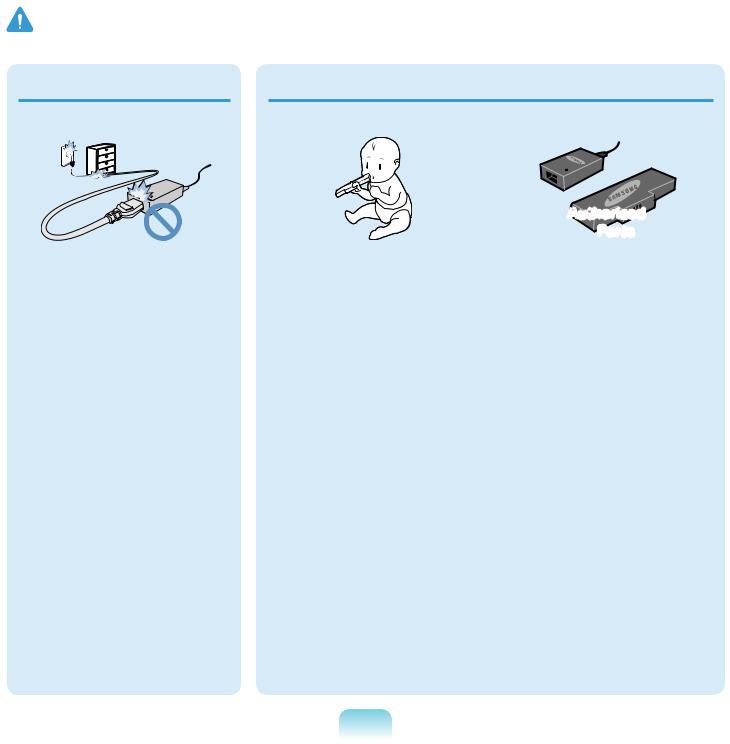
Warning
Failing to follow instructions marked with this symbol may cause personal injury and even fatality.
Battery Usage Related
Authorized
Parts
Do not place heavy objects or step onto the power cord or AC adapter to avoid damaging the power cord or AC adapter.
If the cord is damaged, there is a danger of electric shock or fire.
Keep the battery out of the reach of infants and pets, as they could put the battery into their mouths.
There is a danger of electric shock or choking.
Use an authorized battery and AC adapter only.
Please use an authorized battery and adapter approved by Samsung Electronics.
Unauthorized batteries and adapters may not meet the proper safety requirements and may cause problems or malfunctions and result in an explosion or fire.
10
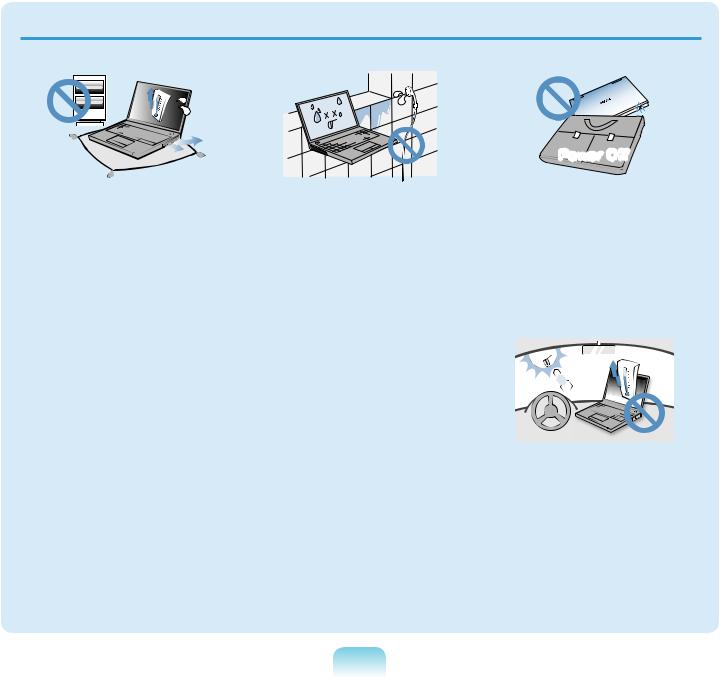
 Warning
Warning
Failing to follow instructions marked with this symbol may cause personal injury and even fatality.
Power Off
Do not use the computer in a badly ventilated location such as on bedding, on a pillow or cushion, etc, and do not use it in a location such as room with floor heating as it may cause the computer to overheat.
Take care that the computer vents (on the side or the bottom) are not blocked especially in these environments. If the vents are blocked, the computer may overheat and it may cause a computer problem, or even an explosion.
Do not use the computer in a humid location such as a bathroom or sauna.
Please use the computer within the recommended temperature and humidity range (10~35ºC, 20~80% RH).
Do not close the LCD panel and put the computer into your bag to move it when it is still turned on.
If you put the computer into your bag without turning it off, the computer may overheat and there is a danger of fire. Shut the computer down properly before moving it.
Never heat the battery or put the battery into a fire. Do not put or use the battery in a hot location such as a sauna, inside a vehicle exposed to the heat, and so on.
There is a danger of an explosion or fire.
11

Warning
Failing to follow instructions marked with this symbol may cause personal injury and even fatality.
Take care not to allow metal objects such as a key or clip to touch the battery terminal (metal parts).
If a metal object touches the battery terminals, it may cause excessive current flow and it may damage the battery, or result in a fire.
If liquid leaks out of the battery or there is a funny smell coming from the battery, remove the battery from the computer and contact a service center.
There is a danger of an explosion or fire.
Please charge the battery fully before using the computer for the first time.
To use the computer safely, replace a dead battery with a new, authorized battery.
12
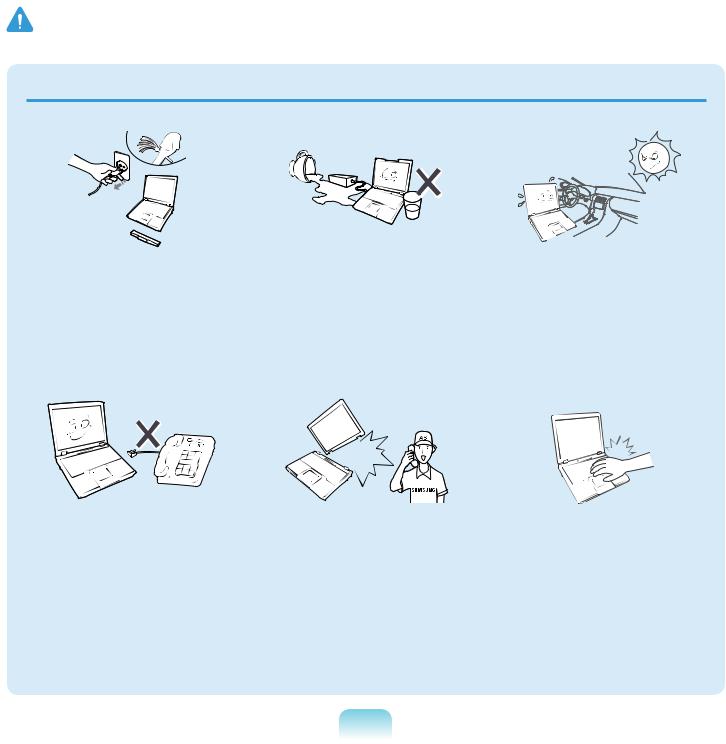
Warning
Failing to follow instructions marked with this symbol may cause personal injury and even fatality.
Usage Related
Disconnect all cables connected to the computer before cleaning it. If you are cleaning a notebook computer, remove the battery.
There is a danger of electric shock or damage to the product.
Do not connect a phone line connected to a digital phone to the modem.
There is a danger of a electric shock, fire or damage to the product.
Do not place any container filled with water or chemicals over or near the computer.
If water or chemicals enter the computer, this may cause fire or electric shock.
If the computer is broken or dropped, disconnect the power cord and contact a service center for a safety check.
Using a broken computer may cause electric shock or fire hazard.
Avoid direct sunlight when the computer is in an air-tight location such as inside a vehicle.
There is a danger of a fire hazard.
The computer may overheat and also present opportunity to thieves.
Do not use your notebook PC for long periods of time while a part of your body is making direct contact with it. The temperature of the product may increase during normal operation.
This may result in harming or burning your skin.
13
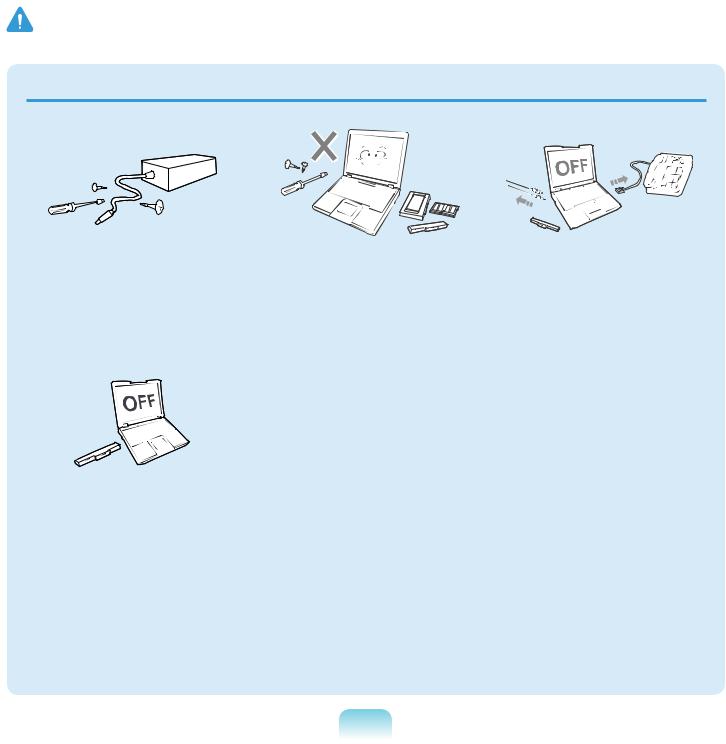
Warning
Failing to follow instructions marked with this symbol may cause personal injury and even fatality.
Upgrade Related
Never disassemble the power supply or AC adapter.
There is a danger of electric shock.
When removing the RTC (Real Time Clock) battery, keep it out of the reach of children as they could touch and/or swallow it.
There is a danger of choking. If a child has swallowed it, contact a doctor immediately.
Use only authorized parts (multiplug, battery and memory) and never disassemble parts.
There is a danger of damaging the product, electric shock or fire hazard.
Shut down the computer and disconnect all cables before disassembling the computer. If there is a modem, disconnect the phone line. If you are disassembling notebook computer, make sure to remove the battery.
Failing to do so, may cause electric shock.
14
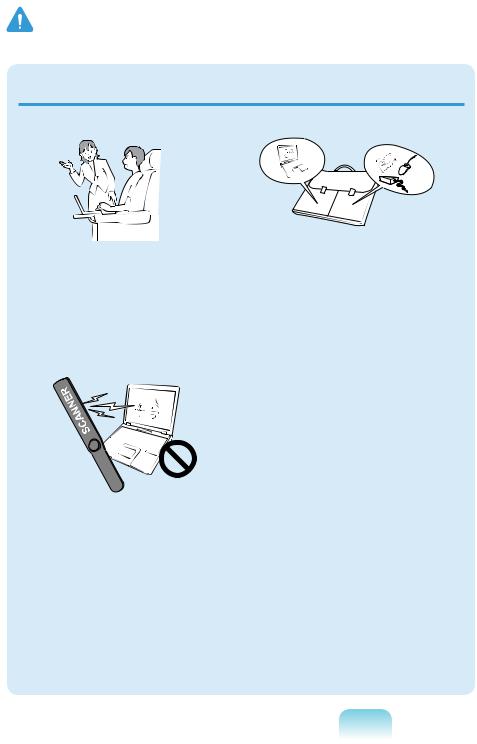
Warning
Failing to follow instructions marked with this symbol may cause personal injury and even fatality.
Custody and Movement Related
Follow the instructions for the relevant location (e.g. airplane, hospital, etc.) when using a wireless communication device (wireless LAN, Bluetooth, etc.).
When carrying the notebook computer with other items, such as the adapter, mouse, books etc, take care not to press anything against the notebook computer.
If a heavy object is pressed against the notebook computer, a white spot or stain may appear on the LCD.
Therefore, take care not to apply any pressure to the notebook.
In this case, place the notebook computer in a separate compartment away from the other objects.
Avoid exposing a drive to magnetic fields. Security devices with magnetic fields include airport walk-through devices and security wands.
The airport security devices that check carry-on luggage, such as conveyor belts, use x-rays instead of magnetism and will not damage a drive.
15

 Caution
Caution
Failing to follow instructions marked with this symbol may cause slight injury or damage to the product.
Installation Related
Do not block the ports (holes), vents, etc. of the product and do not insert objects.
Damage to a component within the computer may cause electric shock or fire.
When using the computer with it lying on its side, place it so that the vents face upwards.
Failing to do so, may cause the internal temperature of the computer to rise and the computer to malfunction or halt.
Do not place a heavy object over the product.
This may cause a problem with the computer. In addition, the object may fall and cause injury, or damage the computer.
Battery Usage Related
Dispose of worn-out batteries properly.
There is a danger of fire or explosion.
The battery disposal method may differ depending on your country and region. Dispose of the used battery in an appropriate way.
Do not throw or disassemble the battery and do not put it into water.
This may cause an injury, fire or explosion.
Avoid contact with metal objects such as car keys or clips when keeping or carrying a battery.
Contact with a metal may cause excessive current and a high temperature and may damage the battery or cause a fire.
Charge the battery according to the instructions in the manual.
Failing to do so, may cause an explosion or fire from damage to the product.
Use only a battery authorized by |
Do not heat the battery or expose it |
|
Samsung Electronics. |
||
Failing to do so may cause an |
to heat (e.g. inside a vehicle during |
|
the summer). |
||
explosion. |
||
There is a danger of explosion or fire. |
||
|
16

 Caution
Caution
Failing to follow instructions marked with this symbol may cause slight injury or damage to the product.
Usage Related
Do not place a candle, light cigar, etc. over or on the product.
There is a danger of fire.
Use a wall outlet or multi-plug with a grounding part.
Failing to do so may cause electric shock hazard.
Make sure to have the product tested by a safety service engineer after repairing the product.
Authorized Samsung Repair Centers will carry out safety checks after a repair. Using a repaired product without testing it for safety may cause an electric shock or fire.
In case of lightning, immediately turn the system off, disconnect the power cord from the wall outlet and phone line from modem. Do not use a modem or phone.
There is a danger of electric shock or fire.
Do not use your computer and AC-Adapter on your lap or soft surfaces.
If the computer temperature increases, there is a danger of burning yourself.
Connect only permitted devices to the connectors or ports of the computer.
Failing to do so, may cause electric shock and fire.
Close the LCD panel only after checking if the notebook computer is turned off.
The temperature may rise and it may cause overheating and deformation of the product.
Do not press the Eject Button while the Floppy Disk/CD-ROM drive is in operation.
You might lose data and the disk might be suddenly ejected and could cause an injury.
Take care not to drop the product while using it.
This may cause personal injury or loss of data.
Do not touch the antenna with electricity facility such as the power outlet.
There is a danger of electric shock.
When handling computer parts, follow the instructions on the manual supplied with the parts.
Failing to do so, may cause damage to the product.
17

 Caution
Caution
Failing to follow instructions marked with this symbol may cause slight injury or damage to the product.
If the computer emits smoke, or there is a burning smell, disconnect the power plug from the wall outlet and contact a service center. If your computer is a notebook computer, make sure to remove the battery.
There is a danger of fire.
Do not use a damaged or modified
CD/Floppy Disk.
There is a danger of damaging the product or personal injury.
Do not insert your fingers into the
PC Card Slot.
There is a danger of injury or electric shock.
Use recommended computer cleansing solution when cleaning the product and only use the computer when it is completely dried.
Failing to do so may cause electric shock or fire.
Emergency disk eject method using paperclip should not be used while the disk is in motion. Make sure
to use the emergency disk eject method only when the Optical Disk Drive is stopped.
There is a danger of injury.
Do not place your face close to the Optical Disk Drive tray when it is operating.
There is a danger of injury due to an abrupt ejection.
Check CDs for cracks and damage prior to use.
It may damage the disc and cause disorder of device and injury of user.
18

 Caution
Caution
Failing to follow instructions marked with this symbol may cause slight injury or damage to the product.
Upgrade Related
Take care when touching the product or parts.
The device may be damaged or you may be injured.
Take care not to throw or drop a computer part or device.
This may cause injury or damage to the product.
Make sure to close the computer cover before connecting the power after a reassembly.
There is a danger of electric shock if your body touches an internal part.
Use parts authorized by Samsung Electronics only.
Failing to do so, may cause fire or damage the product.
Never disassemble or repair the product by yourself.
There is a danger of electric shock or fire.
To connect a device that is not manufactured or authorized by Samsung Electronics, enquire at your service center before connecting the device.
There is a danger of damaging the product.
Custody and Movement
Related
When moving the product, turn the power off and separate all connected cables first.
The product might be damaged or users may trip over the cables.
For long periods of not using the notebook computer, discharge the battery and preserve as it is detached.
The battery will be preserved at its best condition.
Do not operate or watch the computer while driving a vehicle.
There is a danger of a traffic accident.
Please concentrate on driving.
19

 Caution
Caution
Failing to follow instructions marked with this symbol may cause slight injury or damage to the product.
Cautions on Preventing Data Loss (Hard Disk Management)
Take care not to damage the data on a hard disk drive.
A hard disk drive is so sensitive to external impact that an external impact may cause loss of data on the surface of the disk.
Take extra care, because moving the computer or an impact on the computer when it is turned on may damage the data of the hard disk drive.
The company is not liable for any loss of any data caused by a customer’s careless usage or bad environmental conditions.
Causes that may damage the data of a hard disk drive and the hard disk drive itself.
The data may be lost when an external impact is applied to the disk while disassembling or assembling the computer.
The data may be lost when the computer is turned off or reset by a power failure while the hard disk drive is operating.
The data may be lost and irrecoverable due to a computer virus infection.
The data may be lost if the power is turned off while running a program.
Moving or causing an impact to the computer while the hard disk drive is operating, may cause files to be corrupted or bad sectors on the hard disk.
To prevent data loss due to damage to the hard disk drive, please backup your data frequently.
20
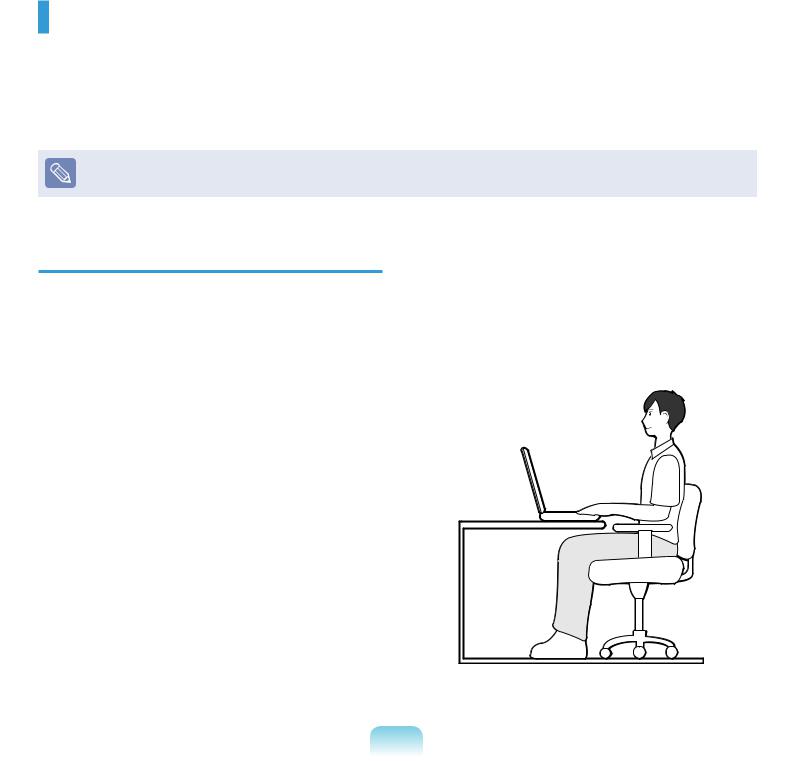
Proper Posture During Computer Use
Maintaining a proper posture during computer use is very important to prevent physical harm.
The following instructions are about maintaining a proper posture during computer use developed through human engineering. Please read and follow them carefully when using the computer.
The instructions in this manual have been prepared so that they can be applied within the coverage of general users.
If the user is not included in the coverage, the recommendation is to be applied according to the user’s needs.
Adjust the heights of desks and chairs appropriate to your height.
The heights are to be adjusted so that your arm forms a right angle when you place your hand over the keyboard while sitting down on a chair.
Adjust the height of chair so that your heel is comfortably placed on the floor.
Do not use the computer while you are lying down, but only while you are sitting down.
Do not use the computer on your lap. If the computer temperature increases, there is a danger of burning yourself.
Work while keeping your waist straight.
Use a chair with a comfortable back.
Keep the center of your leg weight not on the chair but on your feet when you are sitting on a chair.
use a headset. Using the computer with the phone on your shoulder is bad for posture.
Keep frequently used items within a comfortable work range (where you can reach them with your hands).
21
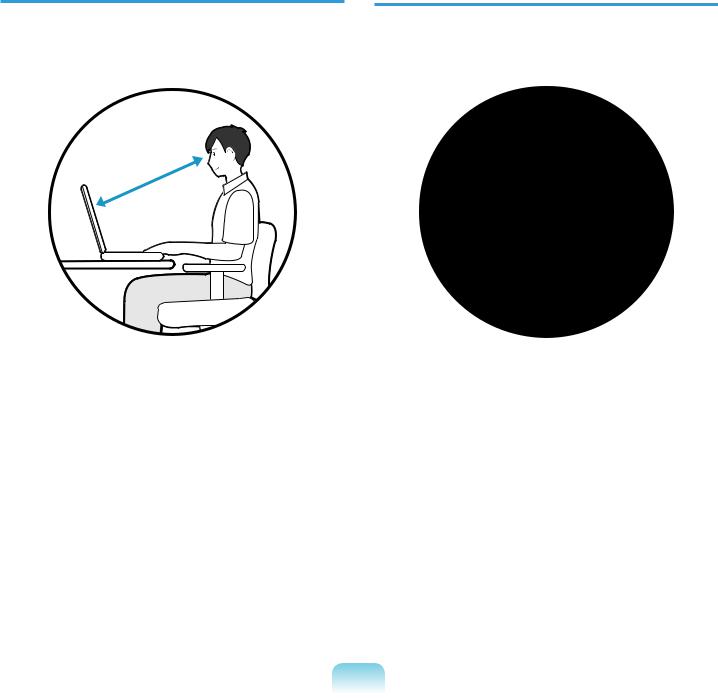
Eye Position
Keep the monitor or LCD away from your eyes by at least 50cm.
50cm
Hand Position
Keep your arm at a right angle as shown by the figure.
Adjust the height of the monitor and the LCD screen so that its top height is equal to or lower than your eyes.
Avoid setting the monitor and LCD excessively bright.
Keep the monitor and LCD screen clean.
If you wear glasses, clean them before using the computer.
When entering contents printed on a paper into the computer, use a static paper holder so that the height of the paper is almost equal to that of the monitor.
Keep the line from your elbow to your hand straight.
Do not place your palm over the keyboard while typing.
Do not hold the mouse with excessive force.
Do not press the keyboard, touchpad or mouse with excessive force.
It is recommended connecting an external keyboard and mouse when using the computer for long periods of time.
22
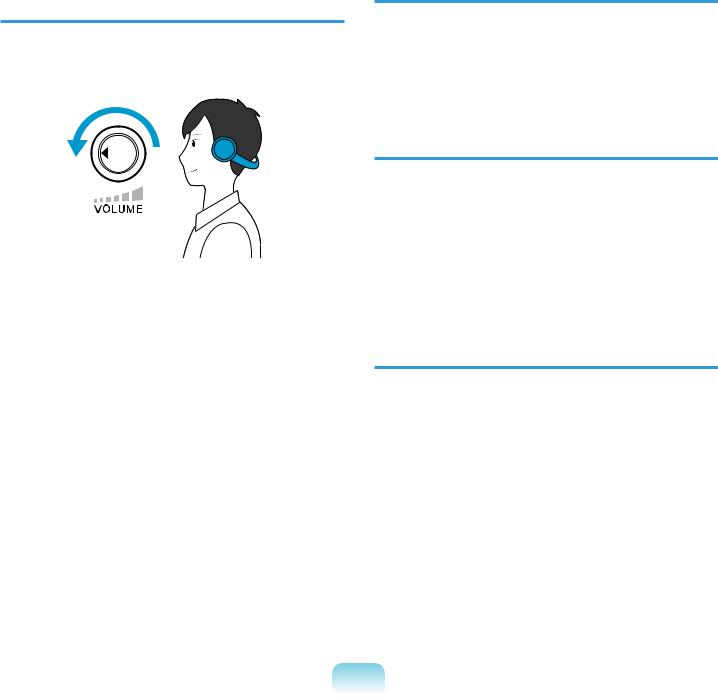
Volume Control
(Headphones and Speakers)
Check your volume first to listen to music.
Check your volume!!
Check if the volume is too loud before using headphones.
It is not recommended using headphones for long periods of time.
Any deviation from the equalizer default setting could cause hearing impairment.
The default setting can be changed through software and driver updates without your intervention. Please check the equalizer default setting before first usage.
Use Time (Break Time)
Take a break for 10 minutes or more after a 50-minute period when working for more than one hour.
Illumination
Do not use the computer in dark locations. The illumination level for computer use must be as bright so for reading a book.
Indirect illumination is recommended. Use a curtain to prevent reflection on the LCD screen.
Operation Condition
Do not use the computer in hot and humid locations.
Use the computer within the allowed temperature and humidity range specified in the User Guide.
23

Important Safety Information
Safety Instructions
Your system is designed and tested to meet the latest standards for safety of information technology equipment. However, to ensure safe use of this product, it is important that the safety instructions marked on the product and in the documentation are followed.
Always follow these instructions to help guard against personal injury and damage to your system.
Setting Up your System
Read and follow all instructions marked on the product and in the documentation before you operate your system. Retain all safety and operating instructions for future use.
Do not use this product near water or a heat source such as a radiator.
Set up the system on a stable work surface.
The product should be operated only with the type of power source indicated on the rating label.
Ensure that the electrical outlet you are using to power your equipment is easily accessible in case of fire or short circuit.
If your computer has a voltage selector switch, make sure that the switch is in the proper position for your area.
Openings in the computer case are provided for ventilation. Do not block or cover these openings. Make sure you provide adequate space, at least 6 inches (15 cm), around the system for ventilation when you set up your work area. Never insert objects of any kind into the computer ventilation openings.
Ensure that the fan vents on the bottom of the casing are clear at all times. Do not place the computer on a soft surface, doing so will block the bottom vents.
If you use an extension cord with this system, make sure that the total power rating on the products plugged into the extension cord does not exceed the extension cord power rating.
24

Care During Use
Do not walk on the power cord or allow anything to rest on it.
Do not spill anything on the system. The best way to avoid spills is to not eat or drink near your system.
Some products have a replaceable CMOS battery on the system board. There is a danger of explosion if the CMOS battery is replaced incorrectly. Replace the battery with the same or equivalent type recommended by the manufacturer.
Dispose of batteries according to the manufacturers instructions. If the CMOS battery requires replacement insure that a qualified technician performs the task.
When the computer is turned off, a small amount of electrical current still flows through the computer.
To avoid electrical shock, always unplug all power cables, remove the battery and modem cables from the wall outlets before cleaning the system.
Unplug the system from the wall outlet and refer servicing to qualified personnel if:
–The power cord or plug is damaged.
–Liquid has been spilled into the system.
–The system does not operate properly when the operating instructions are followed.
–The system was dropped or the casing is damaged.
–The system performance changes.
The Instruction On Safety Operation of
NotePC
zWhen installing and operating devices please refer to safety requirements in the user guide.
xDevices can be used only with the equipment specified in the technical specifications of the devices.
cIf any smell of burning or smoke is detected from the computer the unit should be switched off and battery removed. The unit should be checked by a qualified technician before reuse.
vService and repair of devices should be carried out by authorized service centers.
bDo not allow your portable computer to operate with the base resting directly on exposed skin for extended periods of time. The surface temperature of the base will rise during normal operation (particularly when AC Power is present). Allowing sustained contact with exposed skin can cause discomfort or eventually a burn.
25

Replacement Parts and Accessories
Do not use this product in areas classified as hazardous. Such areas include patient care areas of medical and dental facilities, oxygen rich environments, or industrial areas.
Battery Disposal |
Laser Safety |
Do not put rechargeable batteries or products powered by non-removable rechargeable batteries in the garbage.
Contact the Samsung Helpline for information on how to dispose of batteries that you cannot use or recharge any longer.
Follow all local regulations when disposing of old batteries.
THERE IS A RISK OF EXPLOSION IF BATTERY IS REPLACED BY AN INCORRECT TYPE.
DISPOSE OF USED BATTERIES ACCORDING TO THE INSTRUCTIONS.
All systems equipped with CD or DVD drives comply with the appropriate safety standards, including IEC 60825-
1. The laser devices in these components are classified as “Class 1 Laser Products” under a US Department of Health and Human Services (DHHS) Radiation Performance Standard. Should the unit ever need servicing, contact an authorized service location.
Laser Safety Note:
Use of controls or adjustments or performance of procedures other than those specified in this manual may result in hazardous radiation exposure. To prevent exposure to laser beams, do not try to open the enclosure of a CD or DVD drive.
Class 1M laser radiation when operating part is open.
Do not view directly with optical instruments.
Class 3B invisible laser radiation when open. Avoid exposure to the beam.
26

Connect and Disconnect the AC adapter
The socket-outlet shall be installed near the equipment and shall be easily accessible.
Do not unplug the power cord out by pulling the cable only.
Power Cord Requirements
The power cord set (wall plug, cable and AC adapter plug) you received with your computer meets the requirements for use in the country where you purchased your equipment.
Power cord sets for use in other countries must meet the requirements of the country where you use the computer. For more information on power cord set requirements, contact your authorized dealer, reseller, or service provider.
General Requirements
The requirements listed below are applicable to all countries:
All power cord sets must be approved by an acceptable accredited agency responsible for evaluation in the country where the power cord set will be used.
The power cord set must have a minimum current capacity of 7 A and a nominal voltage rating of 125 or 250 volts AC, as required by each country’s power system. (USA ONLY)
The appliance coupler must meet the mechanical configuration of an EN 60 320/IEC 320 Standard
Sheet C7 (or C5) connector, for mating with appliance inlet on the computer.
27

Regulatory Compliance Statements
Wireless Guidance
(If fitted with 2.4G band or 5G band)
Low power, Radio LAN type devices (radio frequency (RF) wireless communication devices), operating in the 2.4GHz/ 5GHz Band, may be present (embedded) in your notebook system. The following section is a general overview of considerations while operating a wireless device.
Additional limitations, cautions, and concerns for specific countries are listed in the specific country sections (or country group sections). The wireless devices in your system are only qualified for use in the countries identified by the Radio
Approval Marks on the system rating label. If the country you will be using the wireless device in, is not listed, please contact your local Radio Approval agency for requirements. Wireless devices are closely regulated and use may not be allowed.
The RF field strength of the wireless device or devices that may be embedded in your notebook are well below all international RF exposure limits as known at this time. Because the wireless devices (which may be embedded into your notebook) emit less energy than is allowed in radio frequency safety standards and recommendations, manufacturer believes these devices are safe for use. Regardless of the power levels, care should be taken to minimize human contact during normal operation.
As a general guideline, a separation of 20 cm (8 inches) between the wireless device and the body, for use of a wireless device near the body (this does not include extremities) is typical. This device should be used more than 20 cm (8 inches) from the body when wireless devices are on and transmitting.
Some circumstances require restrictions on wireless devices. Examples of common restrictions are listed on the next page:
28

Radio frequency wireless communication can interfere with equipment on commercial aircraft. Current aviation regulations require wireless devices to be turned off while traveling in an airplane.
802.11ABGN (also known as wireless Ethernet or Wifi) and Bluetooth communication devices are examples of devices that provide wireless communication.
In environments where the risk of interference to other devices or services is harmful or perceived as harmful, the option to use a wireless device may be restricted or eliminated. Airports, Hospitals, and Oxygen or flammable gas laden atmospheres are limited examples where use of wireless devices may be restricted or eliminated. When in environments where you are uncertain of the sanction to use wireless devices, ask the applicable authority for authorization prior to use or turning on the wireless device.
Every country has different restrictions on the use of wireless devices. Since your system is equipped with a wireless device, when traveling between countries with your system, check with the local Radio Approval authorities prior to any move or trip for any restrictions on the use of a wireless device in the destination country.
If your system came equipped with an internal embedded wireless device, do not operate the wireless device unless all covers and shields are in place and the system is fully assembled.
Wireless devices are not user serviceable. Do not modify them in any way. Modification to a wireless device will void the authorization to use it. Please contact manufacturer for service.
Only use drivers approved for the country in which the device will be used. See the manufacturer System Restoration Kit, or contact manufacturer Technical Support for additional information.
29

United States of America
USA and Canada Safety Requirements
and Notices
Do not touch or move antenna while the unit is transmitting or receiving.
Do not hold any component containing the radio such that the antenna is very close or touching any exposed parts of the body, especially the face or eyes, while transmitting.
Do not operate the radio or attempt to transmit data unless the antenna is connected; if not, the radio may be damaged.
Use in specific environments:
The use of wireless devices in hazardous locations is limited by the constraints posed by the safety directors of such environments.
The use of wireless devices on airplanes is governed by the Federal Aviation Administration (FAA).
The use of wireless devices in hospitals is restricted to the limits set forth by each hospital.
Explosive Device Proximity Warning
Do not operate a portable transmitter (such as a wireless network device) near unshielded blasting caps or in an explosive environment unless the device has been modified to be qualified for such use.
Use On Aircraft Caution
Regulations of the FCC and FAA prohibit airborne operation of radio-frequency wireless devices because their signals could interfere with critical aircraft instruments.
Other Wireless Devices
Safety Notices for Other Devices in the Wireless Network: Refer to the documentation supplied with wireless Ethernet adapters or other devices in the wireless network.
The Part 15 radio device operates on a noninterference basis with other devices operating at this frequency. Any changes or modification to said product not expressly approved by Intel could void the user’s authority to operate this device.
30
